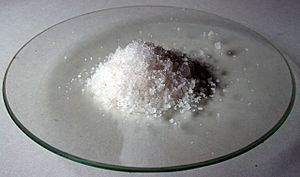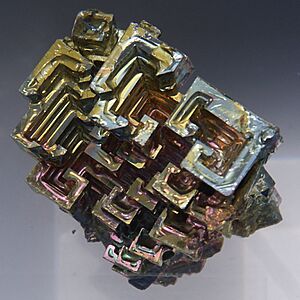Bismuth(III) nitrate facts for kids
Bismuth(III) nitrate is a special chemical compound. It's a type of salt made from the element bismuth and a group of atoms called nitrate. Its chemical formula, Bi(NO3)3, tells us exactly what it's made of. This compound is often found as a white, crystalline solid.
Contents
What is Bismuth(III) Nitrate?
Bismuth(III) nitrate is a chemical compound that combines the metal bismuth with nitrate groups. The "(III)" in its name means that the bismuth atom has a specific electrical charge, or "oxidation state," of +3. This compound is a type of inorganic salt, which means it doesn't contain carbon in the same way living things do.
It looks like a white powder or small crystals. When it dissolves in water, it can sometimes form a cloudy solution because it reacts with water in a special way.
What is Bismuth?
Bismuth is a chemical element, just like oxygen or gold. It has the symbol Bi on the periodic table. Bismuth is a metal, but it's quite unique. It's known for being one of the heaviest elements that is not radioactive, meaning it doesn't break down over time.
You might recognize bismuth because it can have a beautiful, iridescent (rainbow-like) surface when it forms crystals. It's often used in medicines, cosmetics, and even in some types of low-melting alloys, which are mixtures of metals.
What is a Chemical Salt?
In chemistry, a "salt" is not just the table salt you put on food. A chemical salt is a compound formed when an acid and a base react. It's made of two parts: a positively charged ion (called a cation) and a negatively charged ion (called an anion).
In the case of bismuth(III) nitrate, the bismuth part (Bi3+) is the positive ion, and the nitrate part (NO3-) is the negative ion. Together, they balance each other out to form a neutral compound.
Understanding the Formula: Bi(NO3)3
The chemical formula Bi(NO3)3 tells us exactly what atoms make up bismuth(III) nitrate and in what numbers.
- Bi stands for one atom of bismuth.
- NO3 stands for a group of atoms called a nitrate group. This group has one nitrogen atom and three oxygen atoms.
- The small 3 outside the parentheses (NO3)3 means there are three of these nitrate groups for every one bismuth atom.
So, for every single bismuth atom, there are three nitrate groups attached to it.
What is an Oxidation State?
An oxidation state is like a number that tells us how many electrons an atom has gained, lost, or shared when it forms a chemical bond. It helps chemists understand how atoms combine. For bismuth(III) nitrate, the "(III)" means that the bismuth atom has an oxidation state of +3. This means it has essentially "lost" three electrons when it formed the compound.
What is a Nitrate Anion?
An anion is a negatively charged ion. The nitrate anion, written as NO3-, is a specific group of atoms that carries a negative charge. It's made of one nitrogen atom bonded to three oxygen atoms. This group is very common in chemistry and is found in many different compounds, including fertilizers and explosives.
What is Bismuth(III) Nitrate Used For?
Bismuth(III) nitrate has several interesting uses, especially in medicine and other industries.
- Medicine: It has been used in some older medicines, particularly for stomach problems like ulcers and indigestion. It can help protect the stomach lining.
- Cosmetics: Sometimes, bismuth compounds are used in cosmetics, like eye shadows, to give them a pearly or shimmering effect.
- Chemical Reactions: In laboratories, it's used as a starting material to make other bismuth compounds. It can also act as a catalyst, which is something that speeds up chemical reactions without being used up itself.



